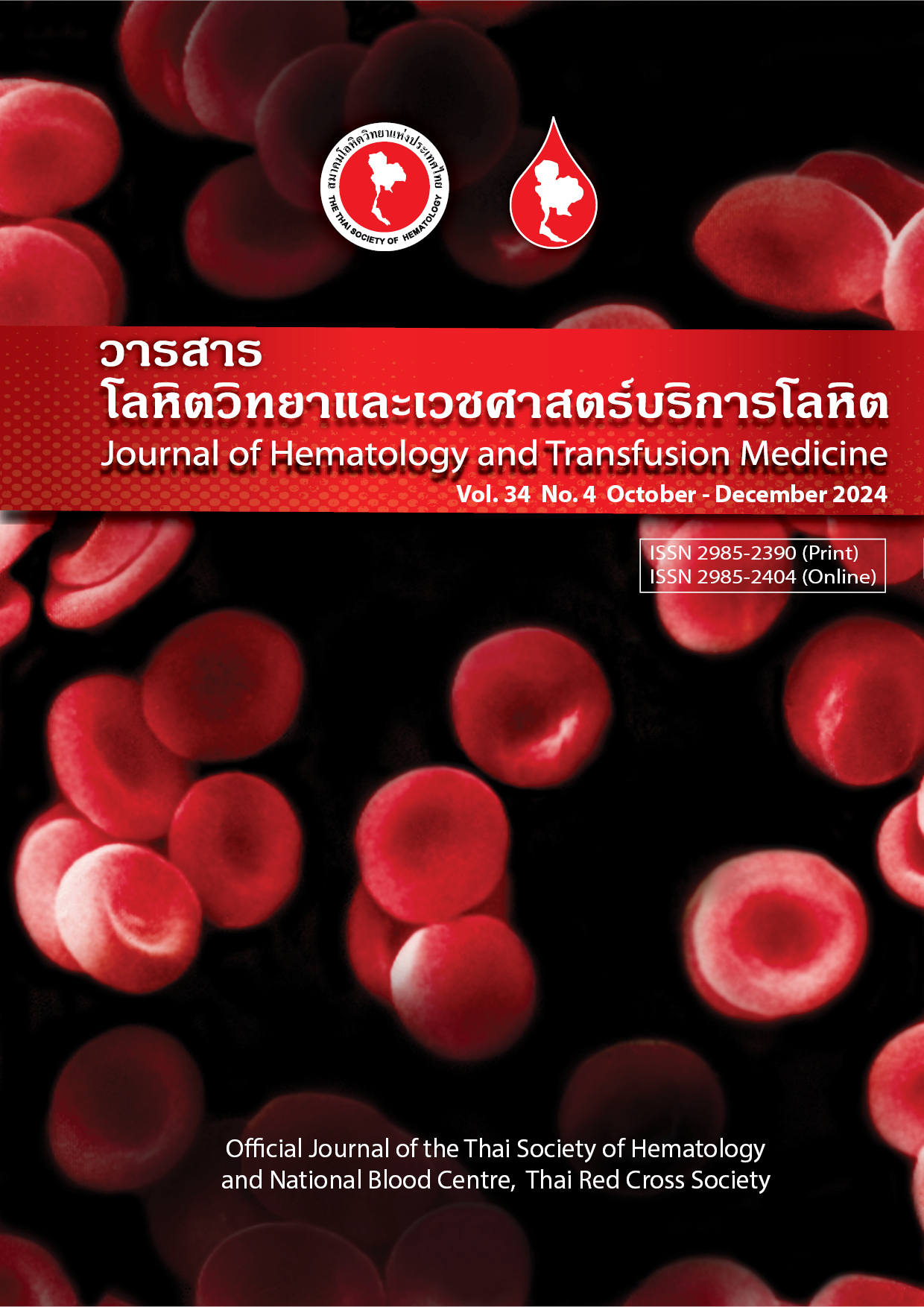Genetic analysis of antithrombin deficiency among Thai patients with thrombosis
DOI:
https://doi.org/10.69898/jhtm.v34.2024.271523Keywords:
Antithrombin deficiency, SERPINC1 gene mutations, thrombosis, Thai population, genetic variationsAbstract
Hereditary antithrombin (AT) deficiency, primarily caused by mutations of SERPINC1 mutations, is a strong risk factor for occurrences and recurrences of venous thrombosis. While AT activity level measurements may be interfered by several factors, genetic analysis is more definitive for diagnosis. This study aims to address the knowledge gap of genetic basis of AT deficiency among Thai patients. Samples were collected from patients with thrombosis and low AT activities. Cases with acquired causes of low AT were excluded. All 7 exons of the SERPINC1 gene were PCR amplified and subjected to Sanger sequencing. The study included 15 patients and 6 controls with normal AT activity levels. The results revealed the presence of 6 benign single nucleotide polymorphisms (SNPs) located in intron 1, 2, exon 5 and intron 5. Two of these SNPs in intron 2 were first described here. Notably, a novel SNP in exon 3, SERPINC1 c.570 C>G (p.Y190X), was discovered. This is likely pathogenic because the premature stop codon led to a non-functional protein. The results suggest that pathogenic SERPINC1 variants detectable by DNA sequencing are uncommon among Thai patients with low AT activity levels underscoring the role of genetic analysis for definitive diagnosis. Further studies involving larger numbers of patients are required.
Downloads
References
References
Carrell RW, Owen MC. Plakalbumin. α 1-antitrypsin, antithrombin and the mechanism of inflammatory thrombosis. Nature. 1985;317:730-2.
Li W, Johnson DJ, Esmon CT, Huntington JA. Structure of the antithrombin–thrombin–heparin ternary complex reveals the antithrombotic mechanism of heparin. Nat Struct Mol Biol. 2004;11:857-62.
Huntington JA, Read RJ, Carrell RW. Structure of a serpin–protease complex shows inhibition by deformation. Nature. 2000;407:923-6.
Zhang W, Swanson R, Izaguirre G, Xiong Y, Lau LF, Olson ST. The heparin-binding site of antithrombin is crucial for antiangiogenic activity. Blood. 2005;106:1621-8.
Corral J, de la Morena-Barrio ME, Vicente V. The genetics of antithrombin. Thromb Res. 2018;169:23-9.
Egeberg O. Inherited antithrombin deficiency causing thrombophilia. Thromb Haemost. 1965;13:516-30.
Lane DA, Bayston T, Olds RJ, Fitches AC, Cooper DN, Millar DS, et al. Antithrombin mutation database: 2nd (1997) update. Thromb Haemost. 1997;77:197-211.
Lee LH, Gallus A, Jindal R, Wang C, Wu CC. Incidence of venous thromboembolism in Asian populations: a systematic review. Thromb Haemost. 2017;117:2243-60.
Antón AI, Teruel R, Corral J, Minano A, Martínez-Martínez I, Ordóñez A, et al. Functional consequences of the prothrombotic SERPINC1 rs2227589 polymorphism on antithrombin levels. haematologica. 2009;94:589.
de la Morena-Barrio B, Orlando C, Sanchis-Juan A, García JL, Padilla J, de la Morena-Barrio ME, et al. Molecular Dissection of Structural Variations Involved in Antithrombin Deficiency. J Mol Diagn. 2022;24:462–75.
Pascreau T, Auditeau C, Borgel D. Hemostatic defects in congenital disorders of glycosylation. Res Pract Thromb Haemost. 2023;7:100142.
De La Morena-Barrio B, Stephens J, de la Morena-Barrio ME, Stefanucci L, Padilla J, Miñano A, et al. Long-read sequencing identifies the first retrotransposon insertion and resolves structural variants causing antithrombin deficiency. Thromb Haemost. 2022;122:1369-78.
Downloads
Published
Issue
Section
License
Copyright (c) 2024 Journal of Hematology and Transfusion Medicine

This work is licensed under a Creative Commons Attribution-NonCommercial-NoDerivatives 4.0 International License.



